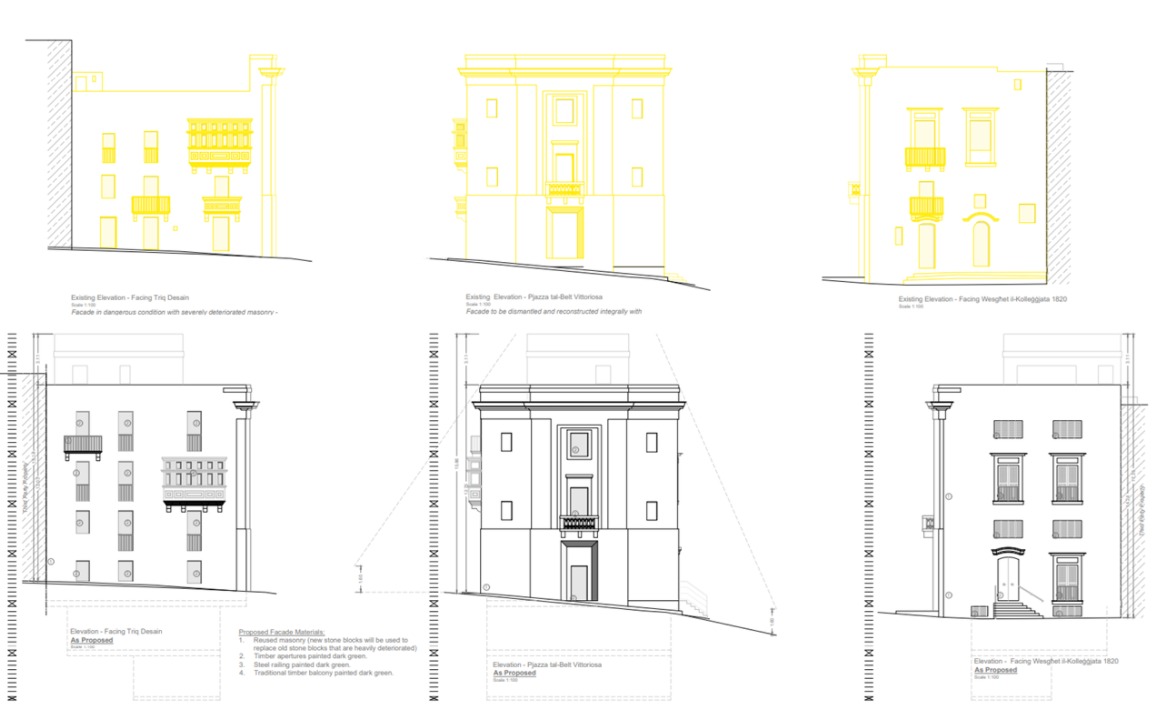A proposed apartment block development in the heart of Vittoriosa’s Urban Conservation Area (UCA) has sparked concern among architects and heritage observers.
They argue that by demolishing a historic property, digging a basement in an archaeologically sensitive area and adding another storey to an iconic skyline, the proposal is a non-starter.
On the other hand, they acknowledge the difficulty – and expense – of any intervention on the site, which was designated as a dangerous structure in 2023.
The current application (PA/05818/25) calls for the transformation of the crumbling corner historic building situated directly beside the Chapel of Our Lady of Damascus, and mere metres away from the iconic Collegiate Church of St Lawrence, into a block of eight residential units.
The site also boasts a façade overlooking Vittoriosa’s main square.
The proposed works include the excavation of basement and reservoir levels, followed by the construction of a duplex maisonette, duplex apartment, five standard apartments, and a penthouse. It claims to retain the original facade and reuse some existing masonry.
The building’s height will also be increased to accommodate another level along with a recessed floor.
The Planning Authority’s Design Advisory Committee has already said it is “not averse to the proposal strictly from a design point of view.”
The application was filed by JBA Periti, a firm best known for its marine infrastructural works, on behalf of Disma Attard.
The building in question has been allowed to decay for decades, its stonework visibly crumbling and balconies falling into disrepair. However, architects contacted by WhosWho.mt argue that full-scale redevelopment is no substitute for a sympathetic restoration.
Both architects were granted anonymity to speak freely.
“The building is clearly of significant antique origins, possibly late-medieval ones,” said one, who expressed his belief that it is “very unlikely it can’t be restored rather than rebuilt.”
The other, however, said the need for demolition is a “tricky question” that would require on-site assessment.
The structure suffered extensive damage during World War II, leading to part of it being reconstructed in the subsequent years, albeit with seemingly substandard materials leading the post-war parts to be in a similarly hazardous condition.
“It’s a patchwork,” said the other architect. “What is certain is that the fabric of the area is extremely sensitive. Any work done needs to be surgical, very finely calibrated. You can’t take a sledgehammer to it.”
Both agreed that digging underground bedrooms is likely to face pushback from the Planning Authority, both due to sanitation rules as well as due to the dense history of the location.
The impact of the extra storey was viewed differently. One noted that several of the surrounding buildings are taller, with the increased height of the site putting it on the same level.
The other, however, said the extra story is likely to raise eyebrows at the Planning Authority.
“The Church of St Lawrence is already barely visible from the square as it is. This development – specifically the recessed floor – will totally block it.”

Above: Existing Structure. Below: As proposed.
There is no clear indication of the eventual use of the building, and whether it will be used as a residential block or for tourist accommodation. Whatever the case, both architects agreed that turning the building into a large house is unlikely to make financial sense.
“The alternative is likely to be simply leaving it dilapidated,” said one. “It’s about restoring sensitively and finding an appropriate use.”
The other architect concluded: “One thing’s for sure: I’m glad I’m not the architect responsible. It’s a tough project.”
The application is currently open for public representations until 10th October 2025.
Main Image:
